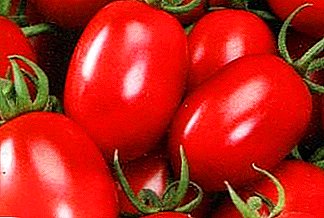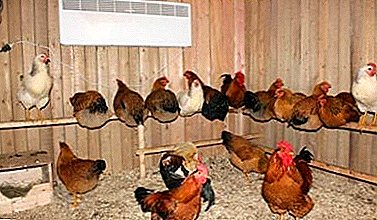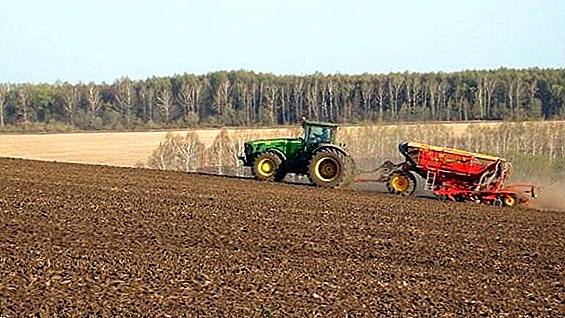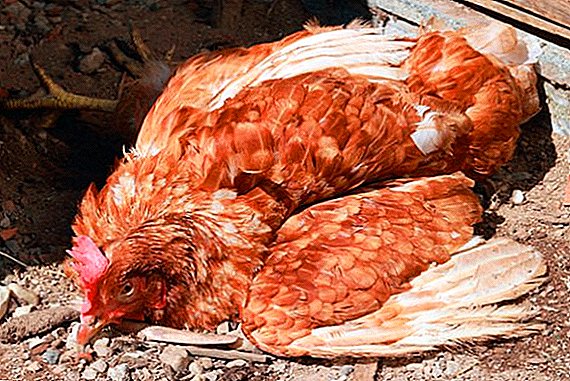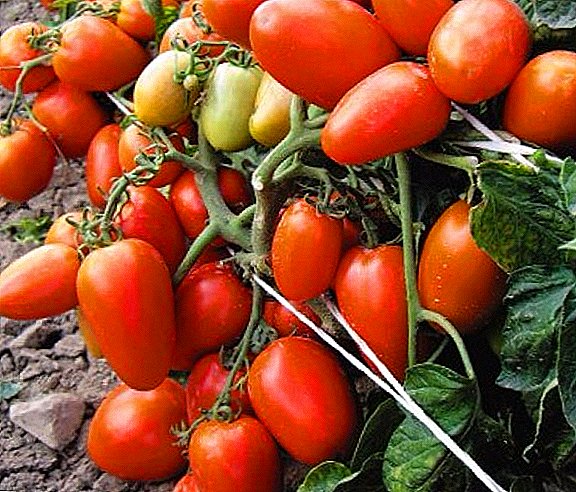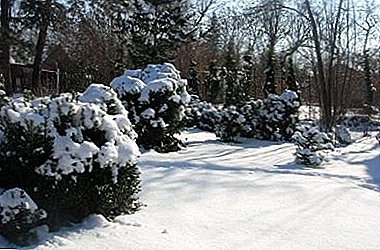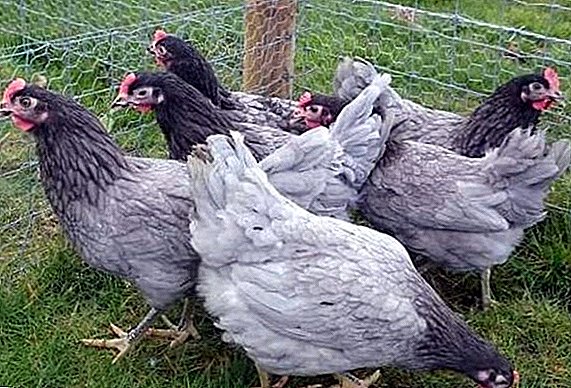 It is believed that in breeding chickens there is nothing original and unusual.
It is believed that in breeding chickens there is nothing original and unusual.
So it is, if it comes to the cultivation of birds with the aim of further obtaining meat and eggs.
What about growing unique layers with blue plumage?
Breeds of blue chickens
Most of the known hybrids of blue chickens were bred by geneticists in the course of numerous crosses of the best representatives of domestic birds. However, it is not so easy to understand that the blue breed chicken is in front of you. 
Regardless of the species, all the chicks have similar external data, so farmers have to wait for the first molt to begin, and instead of down, full-grown feathers of an adult bird will grow. Often the breeders themselves can not predict the exact number of blue breeds in the offspring.
We invite you to get acquainted with the six most popular breeds of blue chickens.
Blue Andalusian Hens
Breeders from Spain have a hand in creating this breed of blue chickens. Crossing Minorok with a black and white color with blue fighting roosters, the scientists developed a new species of blue chickens with an unusual coloring and high egg-laying rates.
High egg production also distinguishes such breeds of chickens as brahma, legbar, moravian black, poltava, white leggorn, hamburg, high-line, new hampshire, hawk white, decalb.
Appearance of Andalusian Blue Chicken:
- head and torso oblong, forehead prominent;
- the crest is large, the cocks are upright, slightly extended at its base, and in the hens it is inclined on its side;
- ear lobes oval white, and beak - dark gray;
- the head is red and the skin is white;
- amber eyes;
- paws are gray with a blue tint.
 Adult chickens are evenly covered with gray-blue feathers, and in adult roosters, the upper body — the mane and the back — has a darker shade. Each feather is bordered by a dark stripe, which gives the hens a particularly “smart” look.
Adult chickens are evenly covered with gray-blue feathers, and in adult roosters, the upper body — the mane and the back — has a darker shade. Each feather is bordered by a dark stripe, which gives the hens a particularly “smart” look.
This color is unstable, and in the offspring of Andalusian hens only half of the chicks have a blue color, the rest have plumage with different shades of gray: from off-white to almost black.
But they are not considered defective for breeding, because when crossing again chickens with such plumage, offspring with a beautiful blue color is obtained. On the first day of life, Andalusian blue breed chickens are evenly covered with soft light yellow and gray down.
The weight of adult roosters - 2.5 kg, and chickens - 2.2 kg. The egg production of the breed is 150-170 eggs, the average egg weight is 60 g, the color of the shell is white. Young layers begin to rush at the age of six months. 
Due to its unique color and high egg production, this breed has received a huge number of admirers among poultry farmers from around the world. In many nurseries Andalusian blue chickens are kept by breeders for the preservation of the gene pool.
These poultry are sensitive to sudden temperature changes, drafts and cold air, so successful breeding of this breed requires the creation of optimal conditions in your nursery.
Did you know? Chickens - one of the few birds that do not divide the eggs into "their own and others." Whose egg would not lay the hen in the nest - she will sit it as required.
Blue Cochin Cocks
The Cochinquin breed is over 150 years old. Cochinchins derived by Chinese breeders received the greatest popularity among European poultry farmers. It is a meat breed, but at present it is grown as decorative birds.
To decorative breeds of chickens include such as Paduan, milfleur, Pavlovskaya.
There are many options for coloring plumage, the most popular - fawn, white, blue and spotted. 
Exterior Cochinachin:
- the body is round, the back is wide, slightly raised in the direction of the tail, the rib cage is well developed;
- comb of small size, leafy;
- oval-shaped lobes, red;
- beak of small size, yellow color, with a slightly downward end;
- eyes deep set. Their coloring depends on the color of the plumage of chickens - in fawn-colored birds the eyes are amber, and in black they are dark-gray;
- legs are short, covered with feathers and set wide, yellow;
- tail and wings short, without long feathers, even in males.
Adults Cochins are completely covered with loose and heterogeneous plumage, even feathers grow on their paws and fingers. Such fluffy plumage gives the shape of a ball to adults.
Representatives of this breed have a calm character and easily adapt to changing environments. Females hatch eggs on their own, and after the birth of offspring do not leave the chickens a single step. 
Nestlings walk practically bald in the first few months of life, chickens mature to eight months of age.
The weight of adult roosters reaches 6-7 kg, and chickens weigh 3.5-4.5 kg on average. The egg production of the breed is 110-120 eggs, with the largest number of eggs being carried in winter. The average egg weight is 55 g, the color of the shell is rich brown.
There is another variety of these blue chickens - dwarf Cochinchins. The only difference is the small size. The weight of adults does not exceed 1 kg, egg production is 75-85 eggs, egg weight is 45 g.
Unusual appearance, small size and unpretentiousness in the care made dwarf Cochinhin favorites among other decorative pets. 
Blue chickens breed Aurora
This breed is the result of long years of work and the numerous breeding of Russian scientists who tried to breed a poultry breed with enhanced productivity and an unusual appearance.
In the process of creating Aurora genetics, various combinations of genes from Australlorp chickens were used:
- males and females of Aurora Blue have a dense plumage of light blue color with a dark border on each feather;
- in cocks, the upper body has a darker color;
- the body is slightly elongated, the head of the roosters is larger than that of the hens;
- the eyes are brown, the beak is a small light gray color, the paws also have the same color;
- it is interesting that both the hens and the roosters on the head have large leaf-like combs of red color, in tone with their beak there are earrings.

The weight of an adult male is 2.5-3 kg, the adult layer - 2-2.5 kg. Egg production during the year - 200-220 eggs, the average weight of each egg does not exceed 60 g, the color of the shell is white. Puberty in layers begins at an early age - the first egg masses are possible as early as 4 months.
Egg production is consistently high in the first couple of years, after - experienced poultry farmers recommend replacing them with young.
Important! In order to increase egg production in Aurora hybrid hens, care should be taken to increase daylight hours to 16 hours. With this lighting mode, egg laying will be almost continuous.
The character of Aurora is calm and cautious, the birds get used to people for a long time and do not like frequent changes in diet and living conditions, they are unpretentious in food. This hybrid is not distinguished by a pronounced instinct of incubation. It is extremely rare to see a picture of how feathered mom Aurora is walking her chickens. 
Blue plumage is unstable and in the second generation makes up half of all offspring. At the same time, the productivity of the rock does not decrease at all.
But, despite the difficulties in growing young stock with parental color, the Aurora Blue breed is in great demand among poultry farmers in Russia, as well as in neighboring countries.
Blue Orpington Hens
In 1987, the English poultry farmer V. Cook made repeated attempts to bring out a unique variety of poultry, one of the requirements for which was white skin.
His numerous attempts at crossing poultry were not in vain - the world was presented with a new breed of chickens with high egg production, white skin and black feather color.
Currently, there are more than ten options for coloring feathers in Orpington hens, the most popular among poultry farmers are such - yellow, porcelain, black and red. 
Let's select the main characteristics of this breed:
- the body is large, the back is wide and muscular, with strong cocks clearly distinguished in roosters, and in chickens it is practically invisible due to the thick feather cover;
- erect ridge, often consisting of 5 or 6 teeth;
- beak large light shades;
- the wings are small and tightly pressed to the body;
- the tail of the hens has a small, fluffy plumage on its back practically hides it, and in roosters the tail feathers are rather long and hang freely downwards;
- legs are shortish and widely set.
Did you know? Chickens and roosters have fairly good intelligence. In the course of numerous experiments, scientists found out that their memory is capable of memorizing the appearance of about a hundred people, and more than thirty sounds were identified that birds used to express their emotions or communicate with each other.
The weight of adult males can reach 7 kg, and in females - 5 kg. The egg production of the breed is 250-280 eggs, the average weight of one egg is 65-70 g. The shell can be either white or yellow. 
Australorp Blue Hens
Australorps were bred in Australia at the end of the 19th century. Black is considered to be the main color, but since chickens of this breed have gained popularity among breeders all over the world, many hybrids have been bred with a wide variety of colors, including blue.
A distinctive feature of this hybrid is a good immunity to many diseases, including typhoid fever - an infectious disease, in most cases leading to the death of poultry.
Appearance:
- Black Australorps have a dense plumage of rich black with a green tint;
- medium sized head and torso;
- amber eyes;
- cocks and scallops are red;
- beak short.
Adult roosters weigh 2.5-3 kg, chickens - 2 kg. Australorps' egg production is 180-220 eggs, but there are cases when layers laid 300 eggs per year. The first egg laying is possible already at the age of four months. The average weight of one egg is 53-57 g, the color of the shell is beige. 
High rates of egg production are stable during the first two years of life; in the third year of life, many poultry farmers prefer to send hens for slaughter.
The advantages of this hybrid should also include simplicity to the conditions of detention and diet, as well as their ability to quickly adapt to changes in temperature.
Important! The disadvantages of the breed, as well as the cause of culling of young blue breeds, are the curvature of the ridge, the spotting of feathers or their reddish tint, the steeply set tail, and the head are white.
Blue chickens breed Araukana
The ancestors of this breed come from South America, where many centuries ago they were domesticated by Indians of the Araucan tribe. The uniqueness of this breed is that most roosters do not have tails, and the hens hatch blue eggs. 
Exterior chickens must meet strict standards, among which are the main ones:
- head small, beak lowered down;
- the body is short, the back is strong and straight;
- chest developed, wide, slightly convex forward;
- the wings are small, pressed to the body;
- eyes are bright orange, red earrings are located near the beak;
- legs are long, gray-green in color, crest is small;
- the tail is absent, and this feature is dominant and is inherited;
- pronounced whiskers and whiskers on the head.
Layers have a calm character, but do not hatch eggs at all. Roosters are capricious and constantly attack opponents on their territory. The body weight of the rooster does not exceed 2 kg, and in chickens it is 1.5–1.7 kg. Egg production - 150-170 eggs, average weight - 55-60 g.
The disadvantages of the breed Araucana include difficulties in breeding and the high cost of young animals. However, despite this, in the world of fans of unusual birds, there are still many who want to try turquoise eggs.
Now you know that among two hundred breeds of chickens there are truly exotic species, the breeding of which can not only provide you with a supply of meat and eggs, but also bring real aesthetic pleasure.



